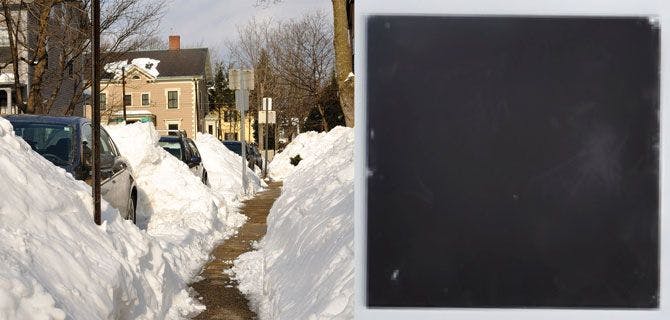Tired of waiting for those mountains of snow hogging precious parking spaces and blocking sidewalks to melt? Now engineers have come up with a simple contraption to shrink those piles quickly: a blanket that absorbs the sun’s rays and conducts heat, melting snow three times as fast as it would melt on its own. Snow […]

Tired of waiting for those mountains of snow hogging precious parking spaces and blocking sidewalks to melt? Now engineers have come up with a simple contraption to shrink those piles quickly: a blanket that absorbs the sun’s rays and conducts heat, melting snow three times as fast as it would melt on its own.
Snow is one of nature’s most reflective materials, says Jonathan B. Boreyko, a mechanical engineer at Virginia Tech who led the new study. Snow piles take a while to melt even if the weather is sunny and above freezing because the sun’s rays bounce off the snow.
The flexible melting mat is simply a 1.3-mm-thick sheet of aluminum that Boreyko and his colleagues spray-painted black on one side. Draped on snow with the black side facing up, the mat can absorb the sun’s heat and transfer it to the snow underneath. “It’s very simple, but nobody’s thought of it. And it works very well,” he says.
The engineers tested 18- by 18-cm mats using acrylic tanks filled with artificially made snow. The tanks were placed inside a 3.5 °C refrigerator under a light source that simulates the sun. The team measured the melting rate of covered and uncovered snow by continually collecting and weighing the melt water. The average melting rate for a square meter of bare snow was 22 g/minute compared with 60 g/minute for covered snow.
Cities—which can spend up to $125 million a year on snow disposal—could find the inexpensive, reusable tool attractive. Pressed for real estate, they hire trucks to haul snow away or blast it with gas-powered heaters, methods that burn fuel and require hours of labor. Melting snow with salt or antifreeze also has drawbacks; the chemicals can corrode cars and contaminate groundwater.
The melting mat is a more polished version of another centuries-old melting technique: spreading soot on snow to make it less reflective, Boreyko says. However, the mat is more effective because it evenly covers the entire top of snow piles. Plus, after the upfront cost of the mat, “you just need the manpower of deploying it over the snow and collecting it after the snow has melted,” he says.
“It is a simple, elegant solution in an engineering sense,” says James F. Campbell of the University of Missouri, St. Louis, who studies the logistics and costs of snow disposal in cities. Many questions will need to be answered before it can be practically applied. The mats seem to work best under bright sun, large mats would need a lot of labor, and large piles of snow might still take a few days to melt under the mats. “It’s a good first step,” he says. “I’d love to see some field testing.”